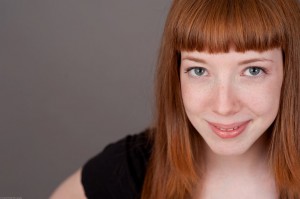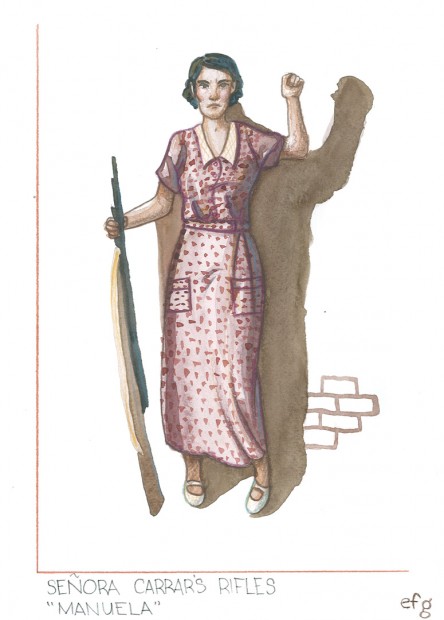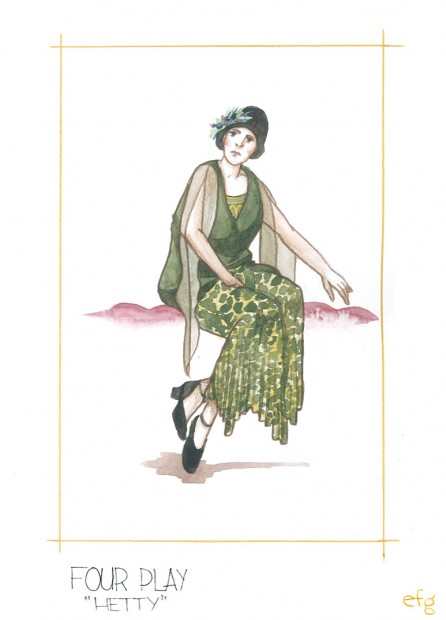Costuming The Shaw Festival Directors Project
by Erin Gerofsky
Costuming The Directors Project at the Shaw Festival, as with any show, presented unique challenges. We rely on making the best use of the incredible stock of garments we have at our costume storage, and must create a unified look that helps to elevate the work and enhance the experience for audience and actor alike.
For Señora Carrar’s Rifles, I had the opportunity to get great inspiration from historical documentation of the Spanish Civil War, and the flexibility to take cues from – but not necessarily strictly recreate – the images I found. Images of militia fighters in work wear, children in oversized jackets, and group photos from orphanages helped to inform the look for Carrar’s son Juan, a primary figure in the play.
He looks young, unprepared for war. We can understand why his mother tries to shelter him and keep him from the front. His clothes are not a perfect fit; perhaps they were once his father’s. Despite how bad things have become around them, Juan Carrar and his mother appear to be doing okay; as she says, “while it lasts, it lasts”. By keeping her fishermen sons at home, Señora has managed to stretch their food and clothing much longer than other families. The other families have suffered greatly and begrudge Señora this selfish act.
Manuela is Jose Carrar’s girlfriend. A young woman in town, she is a strong militia supporter, and believes above all that their cause must be upheld; that freedom is worth dying for. I researched young women who fought for the militia, as well as the Nationalist army for inspiration.
Seeing the stark difference between the two groups of women was incredible. The Loyalists defiant, solemn, and rather rag-tag; the Nationalists exuberant, crisp, clean and uniform. It would only suit to put Manuella in clothes that made clear her poverty. As with Juan, she looks ill equipped for battle in impractical shoes. Perhaps the root of her anger at Señora’s pacifism is her anxiety over the sense of helplessness she feels over the war; there are few rifles left, and when the enemy arrives, the townspeople will have nothing to defend themselves with.
There’s a significant tonal change from Señora Carrar’s Rifles to “FourPlay”, a set of two pieces directed by Krista Jackson. FourPlay consists of If Men Played Cards as Women Do and Overtones. Overtones was a very interesting show to design, because it splits its primary characters into two halves: The refined, reserved “domestic” side, and the abrasive, primal “feral” side.
Harriet is the “domestic” side of the woman married to Charles. Her costume fits into the period the show was written in, 1915. She is constrained by her narrow skirt, a collar that comes up her neck, and she generally oozes a sense of rigid formality. Just from looking at her you’re not too sure if you should trust her. She’s too sweet, too well put together, you know that effortlessness is just a mask. She reveals that it is. Her outfit has been carefully selected to look beautiful but not gaudy. She must be attractive but not appear to be fishing for compliments; she’d rather manipulate you into giving her what she wants. She is the version of Harriet that is easy for us to swallow.
Hetty, on the other hand, may leave a bitter taste in one’s mouth. She is wild, free and rebellious. Krista and I talked very early in the process about setting the primals forward in time from the domestic women. Their 1920’s outfits are less restrictive, allowing the women to move freely and express themselves more boldly.
The feeling that they are unstuck in time adds the fantastical visual element that a show like this needs. The concept of the private face and public face is deeply rooted in the Japanese culture, which was one of the major inspirations for the primals, as well as for the set of the show.
Through this process it has been exciting for me to see the breadth of what we are capable of creating in The Directors Project. Using almost exclusively what already exists in Shaw’s costume storage, the directors and I have created cohesive looks for two vastly different pieces.
As all the design elements come together in these final weeks, it is reassuring to look back on the inspiration that has brought us here and the messages we are trying to express. Above all else, I hope the sets and costumes can help to convey the stories being told in this season’s Directors Project.
 A recent grad of York University’s Theatre Production and Design program, Erin Gerofsky is thrilled to be completing her first season at The Shaw Festival with her solo design for the Directors Project. The Toronto native documents her creative endeavours and new-found small-town life, among other things, at her blog Predictions for the Past.
A recent grad of York University’s Theatre Production and Design program, Erin Gerofsky is thrilled to be completing her first season at The Shaw Festival with her solo design for the Directors Project. The Toronto native documents her creative endeavours and new-found small-town life, among other things, at her blog Predictions for the Past.
Click here to read more posts about the 2012 Shaw Festival Directors Project







Recent Comments